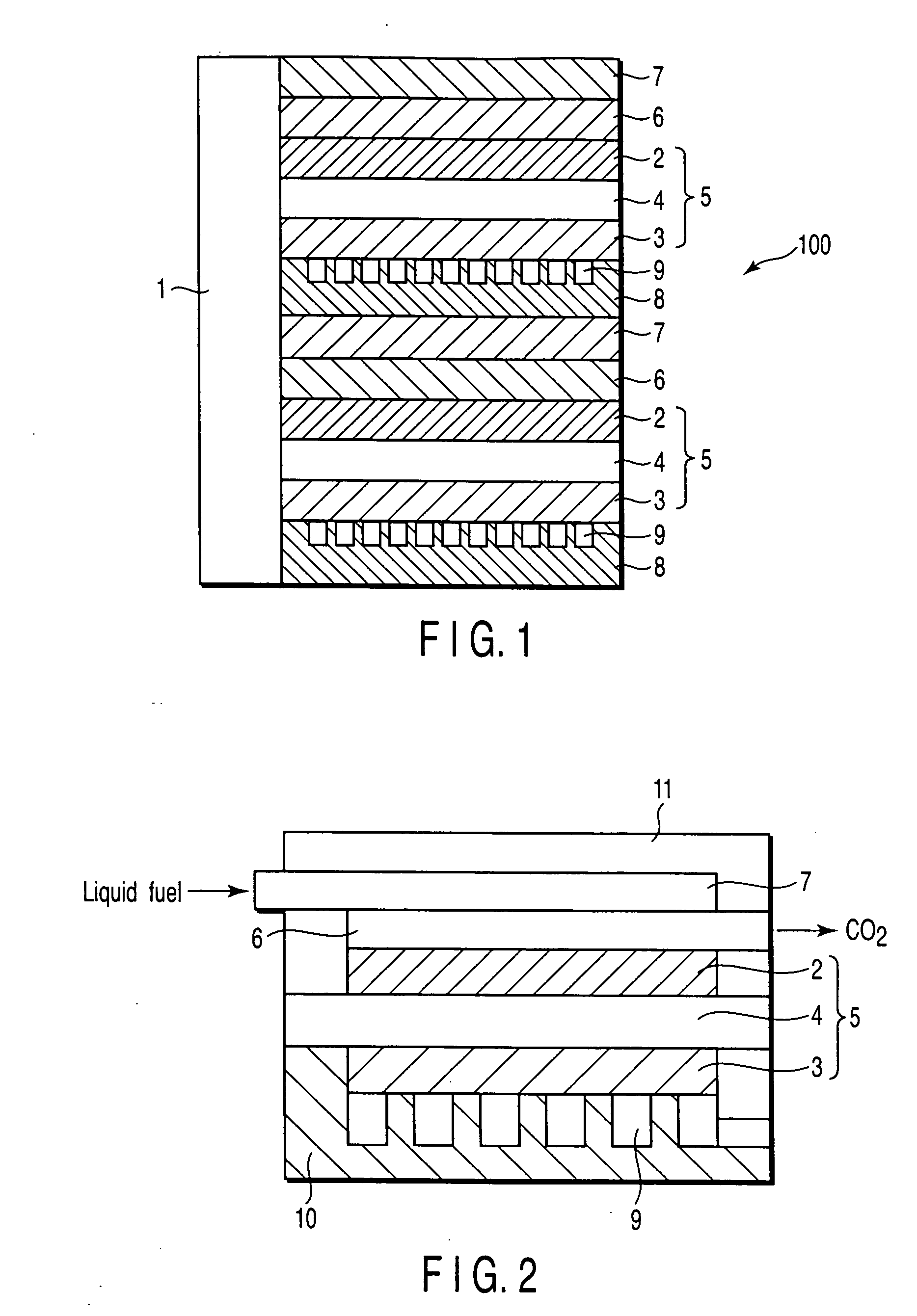Proton conductive solid electrolyte, proton conductive membrane, electrode for fuel cell, membrane electrode assembly, and fuel cell
a proton conductive membrane and solid electrolyte technology, applied in non-aqueous electrolytes, electrical apparatuses, chromium oxides/hydrates, etc., can solve the problems of high system complexity, failure to deliver generated electricity, and inability to obtain stable output, etc., to achieve high output characteristics
- Summary
- Abstract
- Description
- Claims
- Application Information
AI Technical Summary
Benefits of technology
Problems solved by technology
Method used
Image
Examples
example 1
[0108] A mixed solution prepared by adding 5 g of silicon dioxide SiO2 to 300 mL of distilled water having 2 g of vanadium chloride VCl3 dissolved therein was heated to 80° C. while stirring the solution to remove water at an evaporating rate of 100 mL / hour. Then, the residue was left to stand at 100° C. for 12 hours within a drying apparatus to obtain a powdery material. The powdery material thus obtained was pulverized by using an agate mortar, followed by heating the pulverized powdery material within an alumina crucible to 700° C. at a heating rate (temperature elevation rate) of 100° C. / hour. The pulverized material was held at 700° C. for 4 hours to obtain a proton conductive inorganic oxide powder, i.e., powder of a composite material formed of vanadium oxide supported by silicon dioxide. The composite material was found to have 0.1 of an element ratio X / Y of the vanadium element X in the vanadium oxide to the silicon element Y in the silicon dioxide and also have a specific ...
example 2
[0112] A mixed solution prepared by adding 5 g of silicon dioxide SiO2 to 300 mL of distilled water having 3 g of chromium chloride hexahydrate CrCl3.6H2O dissolved therein was heated to 80° C. while stirring the solution to remove water at an evaporating rate of 100 mL / hour. Then, the residue was left to stand at 100° C. for 12 hours within a drying apparatus to obtain a powdery material. The powdery material thus obtained was pulverized by using an agate mortar, followed by heating the pulverized powdery material within an alumina crucible to 700° C. at a heating rate of 100° C. / hour. The pulverized material was held at 700° C. for 4 hours to obtain a proton conductive inorganic oxide powder, i.e., powder of a composite material formed of chromium dioxide supported by silicon dioxide. The composite material was found to have 0.1 of an element ratio X / Y of the chromium element X in the chromium oxide to the silicon element Y in the silicon dioxide and also have a specific surface a...
example 3
[0114] A mixed solution prepared by adding 5 g of silicon dioxide SiO2 to 300 mL of distilled water having 2 g of ammonium molybdate (NH4)6Mo7O24.4H2O dissolved therein was heated to 80° C. while stirring the solution to remove water at an evaporating rate of 100 mL / hour. Then, the residue was left to stand at 100° C. for 12 hours within a drying apparatus to obtain a powdery material. The powdery material thus obtained was pulverized by using an agate mortar, followed by heating the pulverized powdery material within an alumina crucible to 700° C. at a heating rate of 100° C. / hour. The pulverized material was held at 700° C. for 4 hours to obtain a proton conductive inorganic oxide powder, i.e., powder of a composite material formed of molybdenum dioxide supported by silicon oxide. The composite material was found to have 0.1 of an element ratio X / Y of the molybdenum element X in the molybdenum oxide to the silicon element Y in the silicon dioxide and also have a specific surface a...
PUM
| Property | Measurement | Unit |
|---|---|---|
| Temperature | aaaaa | aaaaa |
| Temperature | aaaaa | aaaaa |
| Temperature | aaaaa | aaaaa |
Abstract
Description
Claims
Application Information
 Login to View More
Login to View More - R&D
- Intellectual Property
- Life Sciences
- Materials
- Tech Scout
- Unparalleled Data Quality
- Higher Quality Content
- 60% Fewer Hallucinations
Browse by: Latest US Patents, China's latest patents, Technical Efficacy Thesaurus, Application Domain, Technology Topic, Popular Technical Reports.
© 2025 PatSnap. All rights reserved.Legal|Privacy policy|Modern Slavery Act Transparency Statement|Sitemap|About US| Contact US: help@patsnap.com


